The Influence of power supply converter Fan Vortex on Heat Dissipation(3)

A modular power supply is a power supply that can be directly mounted on a printed circuit board and can be used for application-specific integrated circuits (ASICs), digital signal processors (DSPs), microprocessors, memories, field programmable gate arrays (FPGAs) and other Digital or analog loads provide power. Typically, such modules are referred to as load (POL) power supply systems or point-of-use power supply systems (PUPS). Due to the obvious advantages of the modular structure, modular power supplies are widely used in switching equipment, access equipment, mobile communications, microwave communications, optical transmission, routers and other communications fields, as well as automotive electronics, aerospace, etc.
The fluid passing through the outlet of the axial flow fan is actually the fluid flowing forward along the axis, so what effect does the actual rotation direction of the fan have on the cooled area inside the power supply?
Under the dc switching power supply model, we recalculate the two models by adjusting the rotation direction of the axial fan without changing the mesh division of the model. After the calculation converges, the influence of different fan rotation directions on the heat dissipation of the whole power supply is analyzed by comparing the transition of the flow field and the sectional distribution of the temperature field in the power supply under these two conditions.
By comparing the two analysis results, we found that during the analysis of this model, the direction of fan rotation has a particularly large impact on the distribution of the flow field and temperature field inside the power supply converter. In terms of flow field, because the rectifier bridge part of the model is relatively low in size and the PFC radiator part is relatively high, in this case, the rotating direction of the fan has a very significant impact on the flow field. When the fan rotates clockwise, the vortex around the rectifier bridge radiator is small, and the flow field is relatively open, which is conducive to the heat dissipation of the rectifier bridge radiator. However, when the fan rotates counterclockwise, there are many vortices around the rectifier bridge radiator, which is not conducive to the heat dissipation of the rectifier bridge radiator. These differences can also be further proved by the temperature field distribution of the dc switching power supply supply section.

